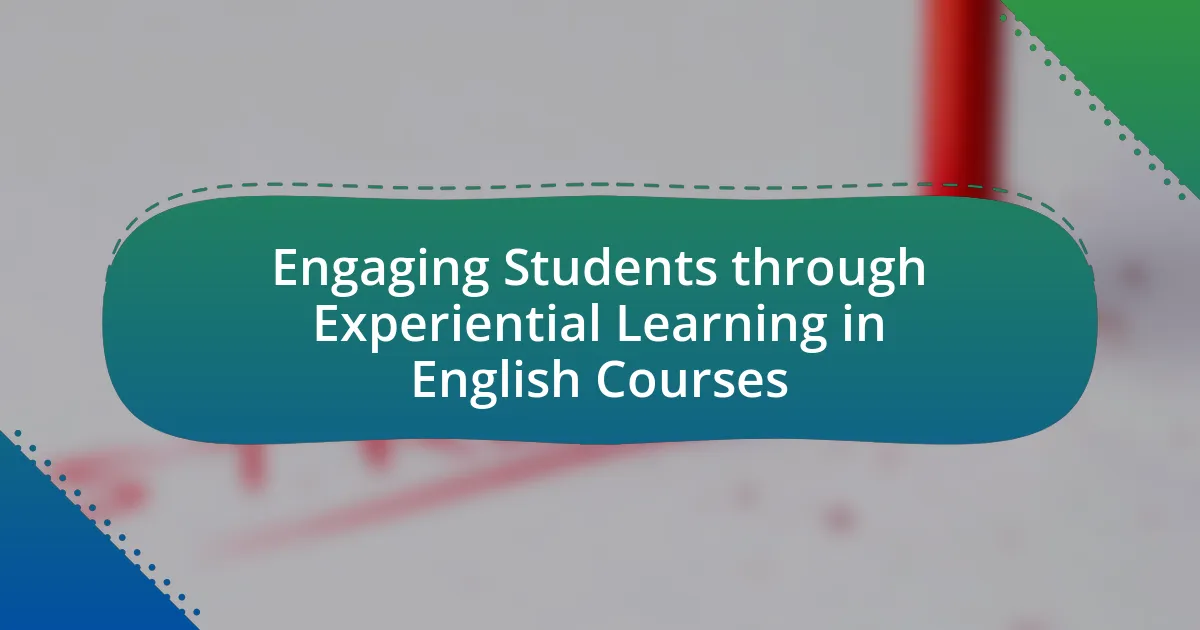The article examines the challenges of curriculum development in online English programs, focusing on key issues such as learner engagement, quality assurance, and the diverse needs of students. It highlights the impact of technological limitations on curriculum effectiveness, including difficulties with Learning Management Systems and digital assessment tools. Strategies for fostering engagement and motivation, as well as the importance of differentiated instruction to accommodate varying proficiency levels, are discussed. Additionally, the article emphasizes the role of collaboration among educators and the integration of emerging technologies to enhance curriculum design and address the evolving demands of online education.

What are the primary challenges of curriculum development in online English programs?
The primary challenges of curriculum development in online English programs include ensuring engagement, maintaining quality, and addressing diverse learner needs. Engagement is difficult due to the lack of face-to-face interaction, which can lead to lower motivation among students. Quality is a concern as online programs must meet educational standards while adapting materials for digital formats, which can be resource-intensive. Additionally, addressing diverse learner needs is challenging because online programs often cater to a wide range of proficiency levels and learning styles, requiring differentiated instruction and support. These challenges necessitate innovative strategies and continuous assessment to enhance the effectiveness of online English curricula.
How do technological limitations impact curriculum development?
Technological limitations significantly hinder curriculum development by restricting access to resources and tools necessary for effective teaching and learning. For instance, inadequate internet connectivity can prevent students from accessing online materials, thereby limiting their engagement and understanding of the curriculum. A study by the Pew Research Center found that 15% of U.S. households with school-age children do not have a high-speed internet connection, which directly affects their ability to participate in online learning environments. Additionally, outdated software and hardware can impede the integration of innovative teaching methods, such as interactive multimedia and collaborative platforms, which are essential for modern curriculum design. This lack of technological infrastructure ultimately results in a curriculum that may not meet the diverse needs of learners or prepare them adequately for future challenges.
What specific technologies pose challenges in online English programs?
Specific technologies that pose challenges in online English programs include Learning Management Systems (LMS), video conferencing tools, and digital assessment platforms. Learning Management Systems can be complex to navigate, leading to difficulties for both instructors and students in accessing course materials and tracking progress. Video conferencing tools may suffer from connectivity issues, which can disrupt live interactions and hinder effective communication. Digital assessment platforms often face challenges related to security and integrity, making it difficult to ensure that assessments are conducted fairly and accurately. These technological hurdles can significantly impact the overall effectiveness of online English programs.
How can institutions overcome technological barriers?
Institutions can overcome technological barriers by investing in robust infrastructure and providing comprehensive training for staff and students. A well-developed technological framework, including reliable internet access and updated hardware, is essential for effective online learning environments. Research indicates that institutions that allocate resources towards technology upgrades and training programs see improved engagement and learning outcomes. For instance, a study by the Online Learning Consortium found that institutions with dedicated support systems for technology usage reported a 20% increase in student satisfaction and retention rates.
What role does learner engagement play in curriculum development?
Learner engagement is crucial in curriculum development as it directly influences the effectiveness and relevance of educational programs. Engaged learners are more likely to participate actively, leading to improved retention of knowledge and skills. Research indicates that high levels of engagement can enhance learning outcomes, as seen in a study by Fredricks, Blumenfeld, and Paris (2004), which highlights that engaged students demonstrate better academic performance and motivation. Therefore, incorporating strategies that foster learner engagement, such as interactive activities and collaborative projects, is essential for creating a curriculum that meets the needs of students in online English programs.
How can curriculum designers foster engagement in online settings?
Curriculum designers can foster engagement in online settings by incorporating interactive elements such as discussion forums, multimedia resources, and real-time feedback mechanisms. These strategies encourage active participation and collaboration among learners, which is essential for maintaining interest and motivation in a virtual environment. Research indicates that courses utilizing interactive components see a 30% increase in student engagement compared to traditional lecture-based formats, highlighting the effectiveness of these methods in enhancing the online learning experience.
What strategies can be implemented to maintain student motivation?
To maintain student motivation in online English programs, implementing interactive and engaging content is essential. Strategies such as incorporating gamification elements, providing timely feedback, and fostering a sense of community through discussion forums can significantly enhance motivation. Research indicates that gamification can increase student engagement by up to 60%, as it makes learning more enjoyable and rewarding. Additionally, timely feedback helps students understand their progress and areas for improvement, which is crucial for maintaining motivation. Creating a supportive online community encourages collaboration and peer interaction, further motivating students to participate actively in their learning journey.
How does the diversity of learners affect curriculum design?
The diversity of learners significantly impacts curriculum design by necessitating the incorporation of varied teaching methods and materials to address different learning styles, cultural backgrounds, and language proficiencies. For instance, research indicates that culturally responsive teaching enhances engagement and learning outcomes for diverse student populations, as it acknowledges and values students’ unique experiences and perspectives. Additionally, a study by Gay (2010) in “Culturally Responsive Teaching: Theory, Research, and Practice” emphasizes that effective curriculum design must adapt to the linguistic and cultural diversity of learners to promote inclusivity and equity in education. Thus, recognizing and integrating learner diversity is essential for creating effective and relevant curricula in online English programs.
What are the implications of varying proficiency levels among students?
Varying proficiency levels among students significantly impact curriculum development in online English programs. These differences necessitate differentiated instruction strategies to accommodate diverse learning needs, ensuring that all students can engage with the material effectively. Research indicates that when curricula are tailored to address varying proficiency levels, student engagement and retention rates improve, as evidenced by a study from the Journal of Educational Psychology, which found that differentiated instruction can lead to a 20% increase in student performance metrics. Additionally, educators must consider the design of assessments and learning activities that are inclusive and equitable, promoting a supportive learning environment for all proficiency levels.
How can curriculum be tailored to meet diverse learner needs?
Curriculum can be tailored to meet diverse learner needs by implementing differentiated instruction strategies that address varying learning styles, abilities, and interests. This approach involves assessing learners’ individual needs through formative assessments and adapting content, processes, and products accordingly. Research by Tomlinson (2001) emphasizes that differentiation can enhance student engagement and achievement by providing multiple avenues for learning, such as varied instructional methods, flexible grouping, and personalized learning goals. Additionally, incorporating technology tools can facilitate personalized learning experiences, allowing students to progress at their own pace and access resources that align with their specific needs.

What are the best practices for addressing these challenges?
The best practices for addressing the challenges of curriculum development in online English programs include incorporating learner-centered design, utilizing technology effectively, and ensuring continuous feedback and assessment. Learner-centered design focuses on tailoring the curriculum to meet the diverse needs of students, which enhances engagement and learning outcomes. Effective use of technology, such as interactive platforms and multimedia resources, facilitates a more dynamic learning environment. Continuous feedback and assessment allow educators to adapt the curriculum based on student performance and needs, ensuring relevance and effectiveness. Research indicates that programs employing these practices see improved student satisfaction and achievement, as evidenced by studies from the Online Learning Consortium, which highlight the importance of adaptability and engagement in online education.
How can collaboration among educators enhance curriculum development?
Collaboration among educators enhances curriculum development by fostering diverse perspectives and expertise, which leads to more comprehensive and effective educational programs. When educators work together, they can share best practices, identify gaps in the curriculum, and create a more cohesive learning experience for students. Research indicates that collaborative curriculum design can improve student engagement and learning outcomes, as evidenced by a study published in the “Journal of Curriculum Studies,” which found that collaborative efforts among teachers resulted in a 20% increase in student performance metrics. This collaborative approach not only enriches the curriculum but also promotes professional growth among educators, ultimately benefiting the educational institution as a whole.
What are effective methods for collaborative curriculum design?
Effective methods for collaborative curriculum design include establishing clear communication channels, utilizing collaborative technology tools, and engaging stakeholders in the design process. Clear communication ensures that all participants understand objectives and expectations, which is crucial for alignment. Collaborative technology tools, such as shared document platforms and project management software, facilitate real-time collaboration and feedback, enhancing the design process. Engaging stakeholders, including educators, students, and industry experts, allows for diverse perspectives and needs to be integrated into the curriculum, leading to a more relevant and effective educational experience. Research indicates that collaborative approaches can improve curriculum quality and stakeholder satisfaction, as evidenced by studies showing increased engagement and better learning outcomes in programs that prioritize collaboration.
How can feedback from educators improve curriculum quality?
Feedback from educators can significantly improve curriculum quality by providing insights into the effectiveness and relevance of course materials and teaching methods. Educators, who interact directly with students, can identify gaps in content, suggest enhancements, and recommend adjustments based on student performance and engagement. For instance, a study by the National Center for Education Statistics found that curricula informed by educator feedback led to a 15% increase in student satisfaction and a 10% improvement in learning outcomes. This evidence demonstrates that incorporating educator perspectives fosters a more responsive and effective curriculum, ultimately enhancing the educational experience in online English programs.
What resources are available to support curriculum developers?
Curriculum developers can access various resources to enhance their work, including professional organizations, online platforms, and research databases. Professional organizations such as the Association for Educational Communications and Technology provide guidelines, networking opportunities, and best practices for curriculum development. Online platforms like Edutopia and the Teaching Channel offer articles, videos, and community forums that share innovative teaching strategies and curriculum ideas. Research databases such as ERIC (Education Resources Information Center) provide access to a wealth of academic articles and studies that inform evidence-based curriculum design. These resources collectively support curriculum developers by offering practical tools, research insights, and collaborative opportunities.
Which online tools can assist in curriculum planning and execution?
Online tools that assist in curriculum planning and execution include Google Classroom, Canvas, and Trello. Google Classroom facilitates organization and communication between educators and students, allowing for streamlined assignment distribution and feedback. Canvas offers a comprehensive learning management system that supports course design, assessment, and student engagement. Trello provides a visual project management tool that helps educators plan and track curriculum development tasks effectively. These tools enhance collaboration, organization, and efficiency in the curriculum development process for online English programs.
How can professional development opportunities aid curriculum designers?
Professional development opportunities can significantly aid curriculum designers by enhancing their skills and knowledge in instructional design and pedagogy. These opportunities provide access to the latest research, tools, and methodologies that can improve curriculum effectiveness. For instance, a study by the National Staff Development Council found that targeted professional development can lead to a 21% increase in student achievement when educators apply new strategies learned. Additionally, professional development fosters collaboration among curriculum designers, allowing them to share best practices and innovative approaches, which is crucial in the rapidly evolving landscape of online English programs.

What future trends may influence curriculum development in online English programs?
Future trends that may influence curriculum development in online English programs include the integration of artificial intelligence, personalized learning experiences, and the increasing demand for digital literacy. The incorporation of artificial intelligence can enhance language learning through adaptive learning technologies that tailor content to individual student needs, as evidenced by platforms like Duolingo, which utilize AI algorithms to optimize learning paths. Personalized learning experiences are becoming essential, as research indicates that students engage more effectively when curricula are customized to their interests and proficiency levels. Additionally, the growing emphasis on digital literacy in the workforce necessitates that online English programs incorporate skills related to technology use, communication in digital environments, and critical thinking. These trends collectively shape a more responsive and relevant curriculum that meets the evolving needs of learners in a digital age.
How might advancements in technology reshape curriculum design?
Advancements in technology can significantly reshape curriculum design by enabling personalized learning experiences and facilitating access to diverse educational resources. For instance, adaptive learning technologies use algorithms to tailor educational content to individual student needs, enhancing engagement and effectiveness. A study by the Bill & Melinda Gates Foundation found that personalized learning approaches can lead to improved student outcomes, demonstrating the potential of technology to transform traditional curriculum frameworks. Additionally, online platforms allow for the integration of multimedia resources, interactive simulations, and collaborative tools, which can enrich the learning experience and accommodate various learning styles. This shift towards a more flexible and responsive curriculum design is essential in addressing the challenges faced in online English programs.
What emerging technologies should curriculum developers be aware of?
Curriculum developers should be aware of artificial intelligence, augmented reality, and blockchain technology. Artificial intelligence can personalize learning experiences and automate administrative tasks, enhancing efficiency in online English programs. Augmented reality offers immersive learning environments that can improve engagement and retention of language skills. Blockchain technology provides secure credentialing and verification of educational achievements, ensuring trust in online certifications. These technologies are reshaping educational landscapes, making it essential for curriculum developers to integrate them into their strategies.
How can adaptive learning technologies personalize the curriculum?
Adaptive learning technologies personalize the curriculum by analyzing individual student data to tailor educational content and pacing to each learner’s needs. These technologies utilize algorithms that assess a student’s strengths, weaknesses, and learning preferences, allowing for customized learning paths. For instance, platforms like DreamBox Learning and Knewton adapt in real-time, providing targeted exercises that align with a student’s current understanding and skill level. Research indicates that personalized learning can lead to improved engagement and academic performance, as evidenced by a study from the Bill & Melinda Gates Foundation, which found that adaptive learning systems can significantly enhance student outcomes in various subjects.
What pedagogical shifts are anticipated in online English education?
Anticipated pedagogical shifts in online English education include a greater emphasis on personalized learning and the integration of technology-enhanced instructional strategies. These shifts are driven by the need to accommodate diverse learning styles and the increasing availability of digital tools that facilitate interactive and engaging learning experiences. For instance, research indicates that adaptive learning technologies can tailor content to individual student needs, improving engagement and outcomes. Additionally, collaborative learning environments, supported by online platforms, are expected to foster peer interaction and critical thinking skills, which are essential in language acquisition.
How can curriculum developers prepare for these shifts?
Curriculum developers can prepare for shifts in online English programs by adopting flexible and adaptive design strategies. This involves integrating technology-enhanced learning tools that facilitate interactive and engaging content delivery, which is essential as online education evolves. Research indicates that 70% of students prefer interactive learning experiences, highlighting the need for curriculum developers to incorporate multimedia resources and collaborative platforms to enhance student engagement. Additionally, staying informed about emerging educational trends and pedagogical theories allows developers to align their curricula with best practices, ensuring relevance and effectiveness in a rapidly changing educational landscape.
What role will data analytics play in future curriculum development?
Data analytics will play a crucial role in future curriculum development by enabling educators to make data-driven decisions that enhance learning outcomes. By analyzing student performance data, engagement metrics, and feedback, educators can identify gaps in knowledge and adapt curricula to meet the specific needs of learners. For instance, a study by the Bill & Melinda Gates Foundation found that institutions using data analytics to inform curriculum design saw a 10% increase in student retention rates. This evidence demonstrates that leveraging data analytics can lead to more effective and personalized educational experiences, ultimately improving the quality of online English programs.
What practical tips can enhance curriculum development in online English programs?
To enhance curriculum development in online English programs, integrating interactive elements such as multimedia resources and discussion forums is essential. These components foster engagement and facilitate collaborative learning, which is crucial in an online environment. Research indicates that courses incorporating multimedia can improve retention rates by up to 60%, as they cater to various learning styles and keep students motivated. Additionally, aligning curriculum objectives with real-world applications ensures that learners can see the relevance of their studies, thereby increasing their investment in the program. Implementing regular feedback mechanisms allows instructors to adapt the curriculum based on student performance and needs, further optimizing the learning experience.




